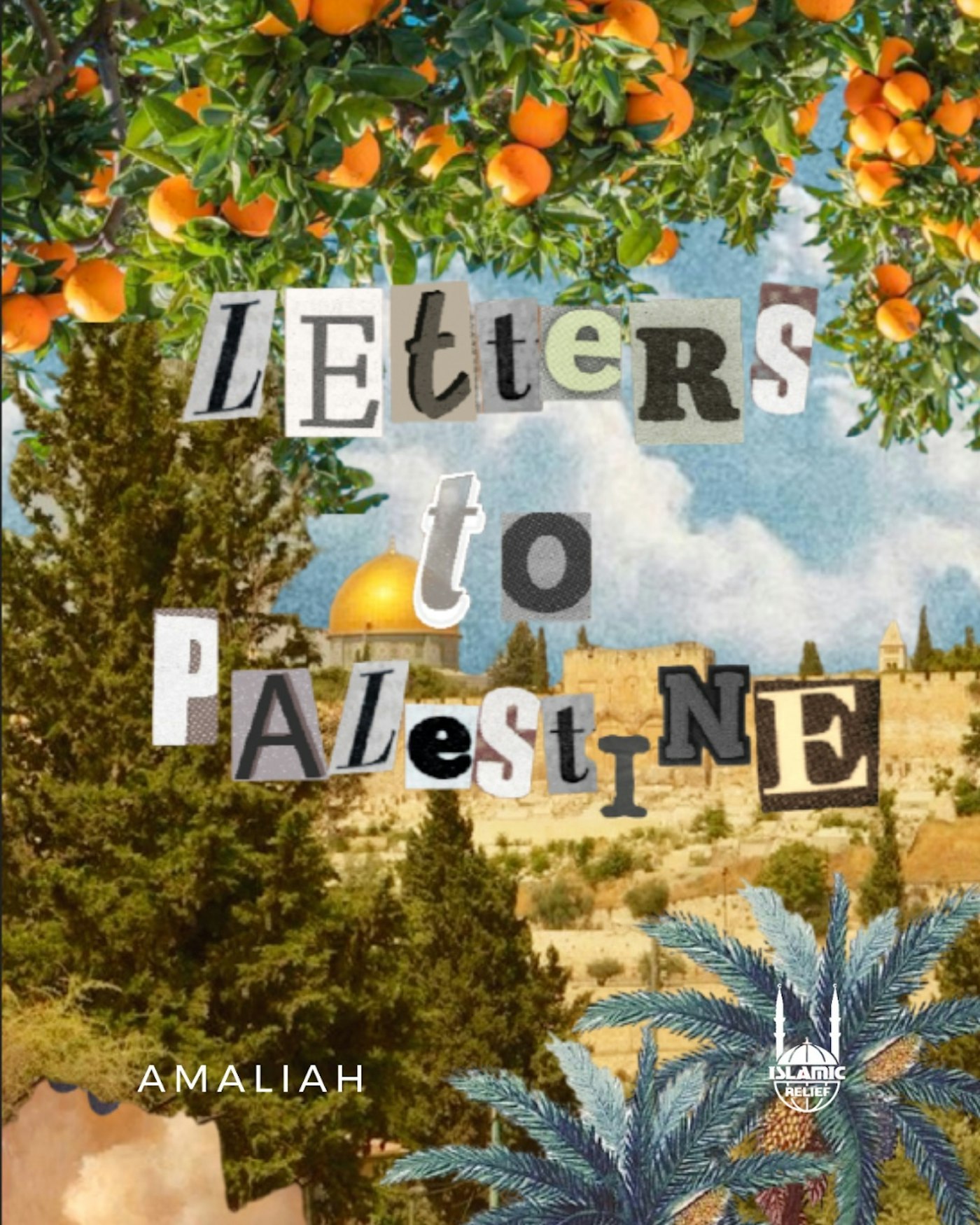
It’s possible that when you think of Palestine, particularly Gaza, endless videos of violence and pain come to your mind. But it is also true that in the face of relentless oppression and displacement, Palestinians have fiercely clung to their culture and identity as acts of resistance. The world might be haunted by images of Gaza, but try as it might, the colonial monstrosity known as Israel has failed to prevent us from getting to know Palestine through its gentle people, its fierce and eloquent poets, the lush olive trees, the oranges of Yaffa, the embroidered thobes from Ramallah in hues of red, green and black, the resounding chants for freedom on the walls of the occupied West Bank and the Palestinian resilience to create art as an act of defiance.
We may have witnessed unspeakable atrocities, but we have also witnessed art becoming a sanctuary, a means to preserve memories, reclaim narratives, and assert Palestinian humanity in the face of dehumanisation. Every expression of creativity becomes a defiance against erasure. A testimony to Palestinian resilience in the face of a modern day Firaun and its cursed army.
Amidst such deliberate and ruthless attempts at the erasure of Palestinians, memories serve as the cornerstone of Palestinian struggle, carrying within them the keys to a collective resistance. They anchor them to their land, history, and shared experiences, forging bonds that transcend borders and generations. Palestinian art in particular immortalises the stories of their ancestors, the pain of the present, and the hope for their future.
Amaliah has partnered with Islamic Relief UK to honour the personal memories and art of two Palestinian women, as they show us how preserving their heritage and culture serves as both a form of resistance and resilience. From intricate Tatreez motifs to powerful art inspired by resistance graffiti, each piece tells a story of perseverance, and the unyielding spirit of a people determined to reclaim their identity and liberation.
This article is in collaboration with Islamic Relief who have been responding since October 2023, and have provided over £10 million worth of aid and delivered over 9 million hot meals. Working closely with their local partners, Islamic Relief have been providing humanitarian relief in Palestine since 1997, serving as a lifeline for communities struggling with the devastating effects of occupation, blockade and recurring conflict. You can support their work on the ground by clicking here.
Teta’s Thoub by Muna El-Zeet (UmZaatar)
Meet Muna El-Zeet aka Umzaatar, whose journey with Tatreez, the traditional Palestinian embroidery, began at the tender age of seven under the guidance of her remarkable grandmother, Sameeha Mosleh. Growing up in Palestine Muna was captivated by her grandmother’s skillful hands, as she would lovingly craft keychains, table covers, tissue boxes, Palestine maps and more to gift to her family and friends. Each piece would be decorated with motifs unique to Palestine and its landscape. At the age of eight, Muna relocated to the UK with her family but remained deeply connected to her Palestinian heritage through frequent visits and the precious Tatreez pieces gifted to her by her grandmother.
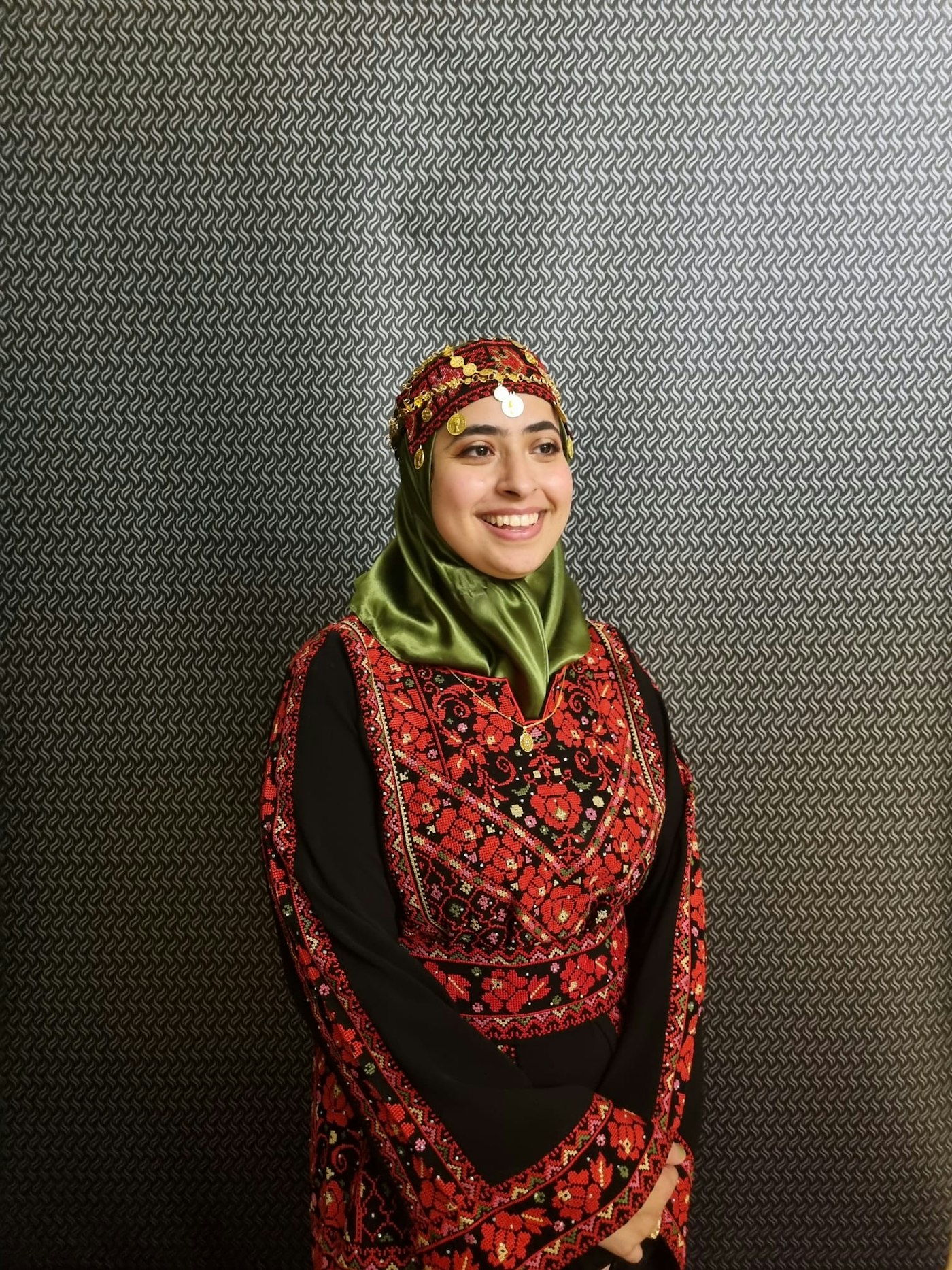
Muna El-Zeet
Muna has recently embarked on a project to finish embroidering a thoub, which is a Palestinian dress. It was started off by her grandmother, but unfortunately it was one that she was unable to complete due to her Alzheimer’s and then her passing.
Muna’s Teta, Sameeha, was an incredible woman. She was displaced from her village of Haifa during the Nakba, at the age of 6. She was then widowed at a young age with eight small children to take care of. Utilising her talent and skills, she became a seamstress stitching uniforms for the village’s children, but continued tatreez as a hobby, crafting beautiful pieces as gifts for family members. Over the years, she visited Muna and her family in the UK, hosting workshops, showcasing the importance of embroidery and connecting with many people despite not knowing a word of English. She didn’t need to; Muna’s Teta impacted people and spoke to them through her art.

Muna’s Teta sewing using her Singer sewing machine table
Muna is sharing the process of Tatreez embroidery and her journey on her Instagram account as a way to honour her grandmother’s memory and keep the spirit of Palestine alive through her stitches. Her influence continues to shape Muna’s artistic journey profoundly.
Can you share your journey as an artist and how your heritage influences your work?
Muna: I learned embroidery at a young age from my grandmother, just as my cousins did. The first time she actively taught me was when we were living in Ramallah and the first thing I made was a necklace with a Palestinian flag on it, which I still have until this day.
Initially, I leaned towards Western embroidery, but I rediscovered Palestinian embroidery when my grandmother developed Alzheimer’s. Despite being unable to communicate with us, she continued to embroider due to her incredible muscle memory. It was a poignant reminder of our shared heritage and I was drawn back to Tatreez, realising the importance of preserving Palestinian culture and heritage. I’m probably the only one among my cousins who still embroiders. I found her whole process, from conceptualization to execution, awe inspiring. Embroidery requires patience and time, which is probably why many people don’t take it up. But it’s rewarding to pass on this skill, especially through my workshops and speaking to people about it; continuing her legacy is now important to me.
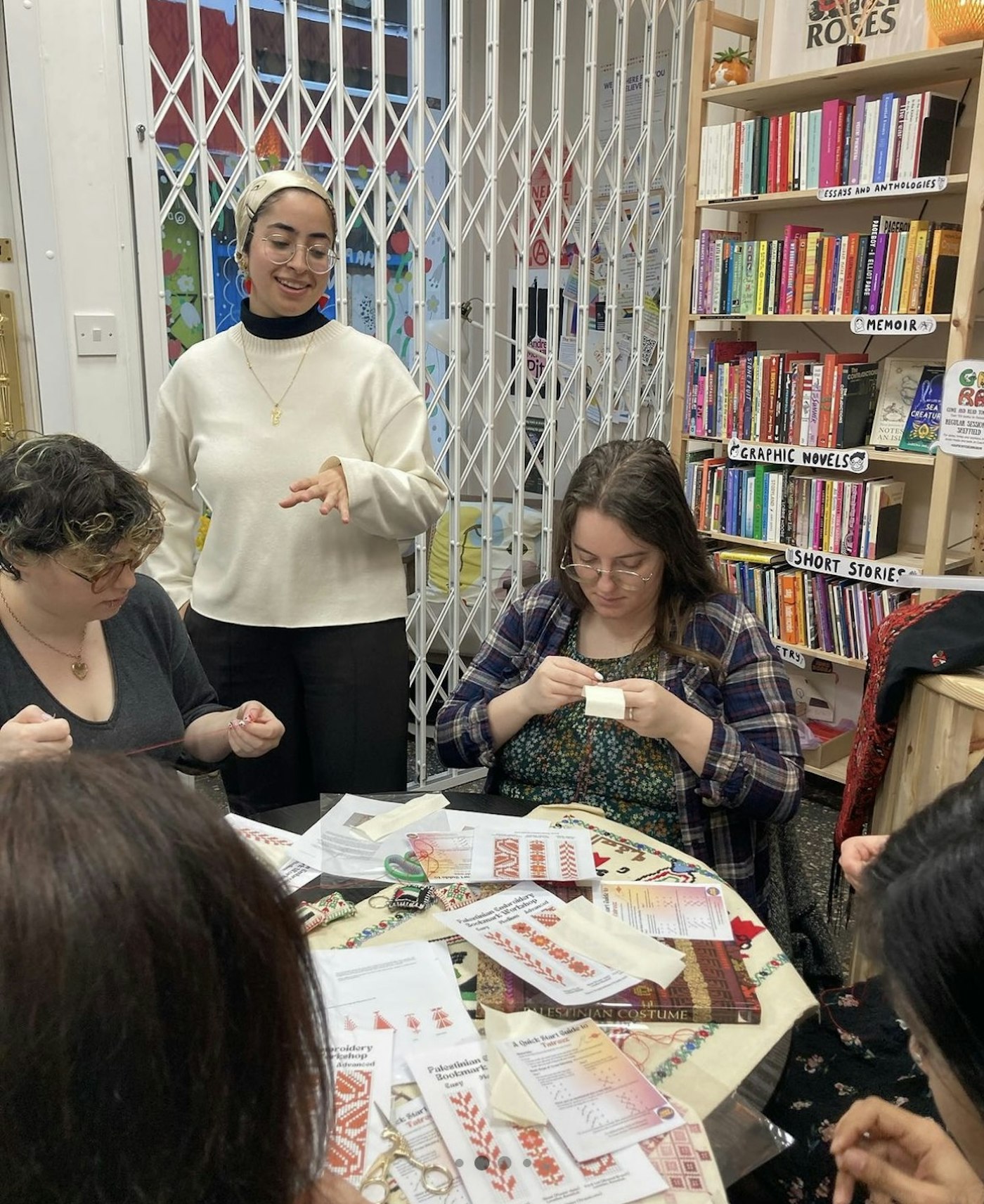
Building Community and Connections through Tatreez workshops
When did you start your current project?
Muna: I’ve been doing small pieces of Palestinian embroidery for a couple of years. During my last visit to Palestine in 2023, my aunt, while admiring my work mentioned an unfinished project of my grandmother’s—a thoub, a traditional Palestinian dress. She encouraged me to finish it and just knowing I might have the chance to complete her work and be part of something she made, was a very emotional moment for me. My aunt estimated that my grandma began it about 10 years ago. She passed it to me to finish, and I eagerly accepted. It felt like a way to reconnect with my Teta and carry on her legacy.
I came back on 6th October 2023 and the next day everything kicked off in Palestine again. That’s when I also felt a real need for community and to connect with other people. So I reached out to a few friends and decided to host embroidery workshops, infused with meditation to offer art therapy. The response has been incredible. People are not only interested in learning embroidery but also in the stories and history behind it. It’s been truly fulfilling.
How do you balance between personal expression and the broader sociopolitical context in your art?
Muna: It’s very difficult to separate our culture and identity from politics, particularly given our history of struggle and resistance. It’s sad that all we have is struggle, but it’s also important to recognize how holding on to and continuing Palestinian embroidery, with its rich patterns rooted in centuries of tradition, symbolises our resilience.
For me as a Palestinian in the UK, I avoid overtly political statements to ensure ease of travel to Palestine. Instead, I draw from my experiences to subtly incorporate cultural elements into my work. Simply expressing our identity is also a form of resistance. I think it is impactful when people ask me: Where are you from? And I say I’m Palestinian instead of British, even though I identify with both. This gives me a chance to assert the fact that Palestinians are still existing.

Visiting Sheffield, Peak District
Are there specific themes or symbols in your artwork that relate to Palestinian resistance and identity?
Muna: Absolutely. There is a lot of history behind each pattern, often tracing back to specific villages or areas in Palestine. These patterns serve as a testament to how we’ve always been intertwined in the fabric of society. Additionally, Palestinian women have used embroidery on their thoubs to showcase their existence as resistance, including stitching Palestinian flags inside their thoubs when they were banned in 1967. There are variations in symbols based on the region too, which is so interesting and fun to see. For example, the motif for the cyprus tree will vary from Ramallah to Gaza to Khalil, offering a reflection of our collective history and resilience.
Do you think your work adds to the conversation in the Palestinian diaspora right now?
Muna: While I see my efforts as simple activities, collectively they can have a bigger impact. It’s about making our presence known and our culture visible. If every person in the diaspora engages with aspects of our culture, be it art, embroidery, or food, it will help preserve our identity and forge community bonds. If we let go of these, we will lose our identity.
I’ve been reflecting on how I can create a positive impact for Palestinians from the outside. My father imports Palestinian products to the UK, which supports and empowers Palestinian farmers back home. I simply followed his footsteps by donating proceeds from my workshops to charity. So even though my financial impact is small, I believe our work will always be rooted in trying to help our communities back home. Additionally, through my workshops, I hope the influence of teaching people about our culture and history can be greater. Recently I’ve noticed an increased interest in the preservation of our culture in the form of resources, libraries and archives, which are needed to hold on to our culture, our values and our resistance against the ethnic cleansing that’s happening.
Have you faced any particular challenges or obstacles as a Palestinian artist living in the UK?
Muna: Not at the moment as I’m still in the early stages of my journey. The main challenge is the politicisation of my identity. Simply expressing my Palestinian heritage can sometimes lead to assumptions or uncomfortable reactions. People freeze up or question my motives when I proudly display symbols of my culture, such as simply wearing a Palestinian flag pin. It’s exhausting to navigate these reactions and constantly second-guess how to share my identity. However, I’ve found that using my embroidery as a conversation starter can be empowering. Recently, I’ve adopted a more unapologetic approach to expressing that I am a Palestinian, and not caring about what people might say.
Has your art sparked conversations or connected you with someone outside the Palestinian community?
Muna: It is amazing how embroidery is universal and creates bonds between different communities. When I mention Palestinian embroidery, people are eager to share their own cultural embroidery traditions. I have a friend who’s Hungarian who also embroiders. We discovered many similarities between Hungarian and Palestinian embroidery, bonding over shared patterns and techniques. Sometimes you might mistake a design for being European, but it will be Palestinian; and it just shows how interconnected we all are. I believe our shared experiences across cultures may not be visible, but they unite us in many ways.
My friend recently gifted me a beautifully embroidered map of Palestine as a way of expressing solidarity and understanding with me. It was a beautiful gesture and in the process she supported a Palestinian artist on Etsy, who created the pattern of the map for her. Similarly, participants from my workshops often reach out for advice on continuing their Tatreez learning journey. I think it would make my Teta really proud, knowing that her craft continues to reach so many people.
For Muna, the memories of her incredible grandmother and her ongoing efforts to complete her thoub are more than just a means of staying connected to her family. Her grandma might have been displaced during the original Nakba, but carried the skills that kept their culture and identity alive which she then passed on to Muna who now lives in the UK. And now Muna, through her embroidery and her workshops, not only pays tribute to her grandmother’s legacy, but each stitch of hers symbolises Palestinian existence, their identity and a deep-rooted connection to Palestine. Ultimately, every motif is a commitment of resistance to the occupation and a hope for liberation.
Art for Liberation by Mouna Kalla-Sacranie (Mks_Prints)
Mouna Kalla-Sacranie is of Palestinian-Indian heritage and lives in London. As a teenager, Mouna was passionate about drawing, painting and loved making things by hand. She even had dreams of opening up her own art school. However, soon after graduating she landed herself a corporate job, due to which her creative pursuits took a bit of a back seat for a couple of years.
Mouna says that after October 7th, everything changed for her as she found herself glued to the news, unable to process the horror that Palestinians in Gaza were facing. In the landscape of artistry and activism, Mouna’s work amplifies the Palestinian resistance and hope for liberation from the occupation. Working with mixed media materials, she creates intricate art posters and prints that reflect her Palestinian heritage and the spirit of resistance that are often found in protest graffiti art across the walls of West Bank and occupied Palestine
Mouna creates everything by hand and then finishes them off digitally. She loves using a scalpel as a drawing tool and primarily works on paper. Most of her pieces combine free-hand illustration, mixed-media collage and paper cutouts. To add depth, pattern and texture, she also incorporates lino printing and hand-carved stamps, as well as handwritten Arabic text.

The theme of return echoes throughout Mouna’s work
Inspired by the powerful messages scrawled on walls, Mouna’s work embodies a sense of urgency and purpose. One of her first and most notable piece is a powerful poster bearing the proclamation “Resist, Exist, Return,” serving as a rallying cry for justice and freedom. The correlation between the keys on the poster and the actual physical keys of homes lost during Nakba, that many Palestinians still hold and pass on to their younger generations is clear to anyone familiar with the Palestinian struggle.
In 2016, Mouna was able to spend some time in Al-Quds (Jerusalem) during the last ten days of Ramadan. She hasn’t been back to Palestine since that trip but would love to return, especially to visit the town where her father was born. Mouna’s artistic journey is a testament to the enduring spirit of her Palestinian heritage and is the sole reason for her work’s existence.

From the Archive of Mouna Kalla-Sacranie
Could you tell us more about the inspiration behind your art and what it aims to convey?
Mouna: I am endlessly fascinated and inspired by protest art and often find myself searching for references and inspiration on the Palestine Poster Project Archive. Almost all of my work also incorporates text, so in many ways, each piece has its own direct message. The words I choose largely inspired by poetry (Darwish, el-Kurd), literature (Kanafani, Baldwin, Morrison) and Palestinian protest slogans, are there to serve as a reminder, a demand and a call to action.
Why and when did you decide to embark on this project?
When everything kicked off in October, like so many others, I found myself glued to my phone refreshing the news obsessively, unable to process my horror or my grief. I remember scrolling through Instagram one afternoon when I came across an image of a wall on @baladbox, which had the words “No peace without justice. No justice without return” spray painted onto it. The words went round and round in my head all day on a loop. It was the first time in years I had felt inspired to create something. So that’s exactly what I did.
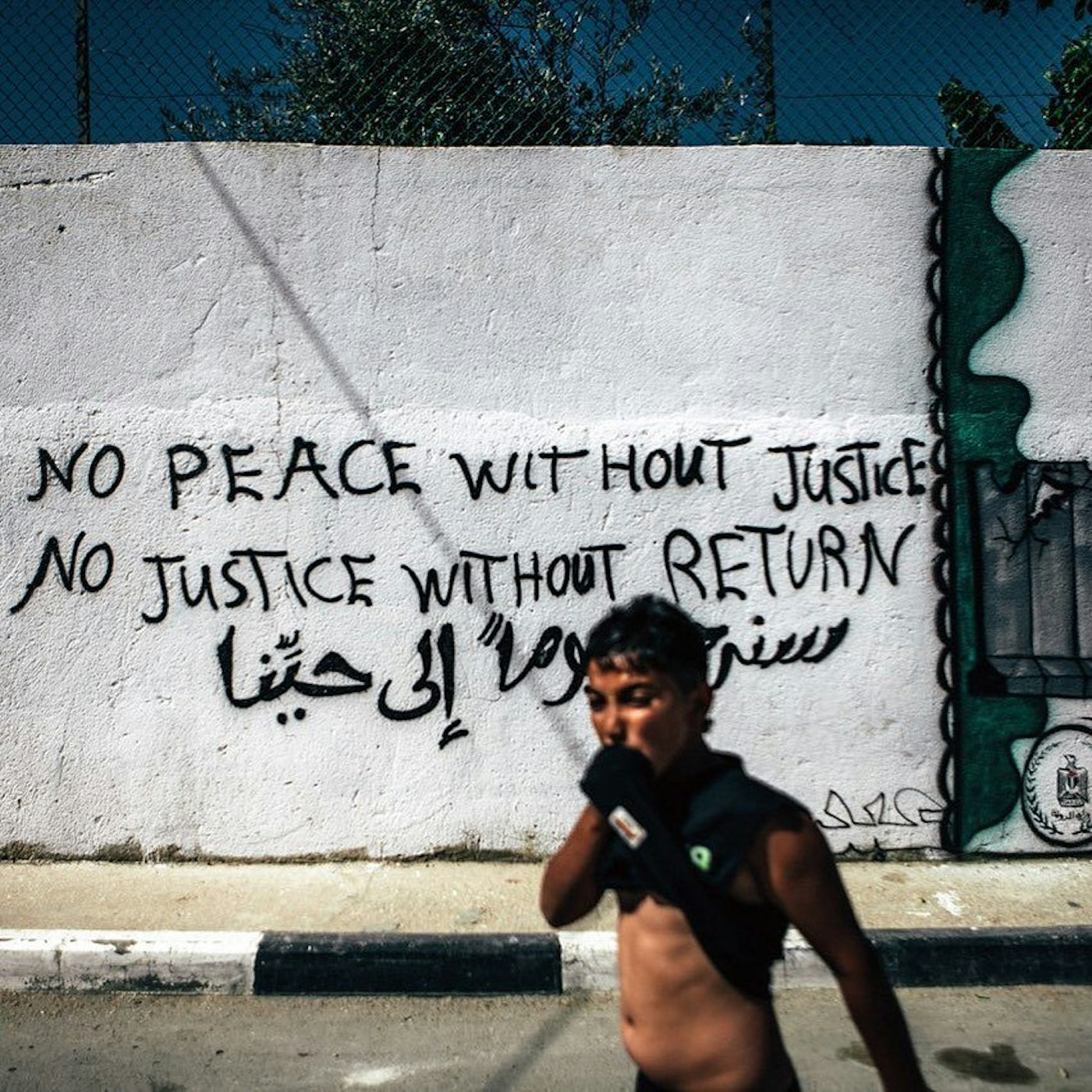
Resistance Graffiti Art serves as Mouna’s inspiration
Up until that point, it felt like nothing I was doing (boycotting, marching, sharing, donating) was enough. I wanted to do more. So shortly after creating the “No peace” print, I started selling my work online and producing things more consistently. For the last couple of months, I’ve been donating 100% of all my proceeds each month to different charities and initiatives that are supporting humanitarian efforts on the ground in Palestine.
What steps did you take to ensure it’s done properly?
Mouna: From the artistic side of things, I always make sure to explicitly reference my visual or literary inspirations, citing source material where necessary to ensure that every piece I create feels like it’s building on something that’s come before. From the charity side, I have been periodically donating to reputable locally-embedded organisations or verified evacuation funds to ensure that the money is reaching those who need it most. I update my (small but lovely) following each month so they can see where their support is going.
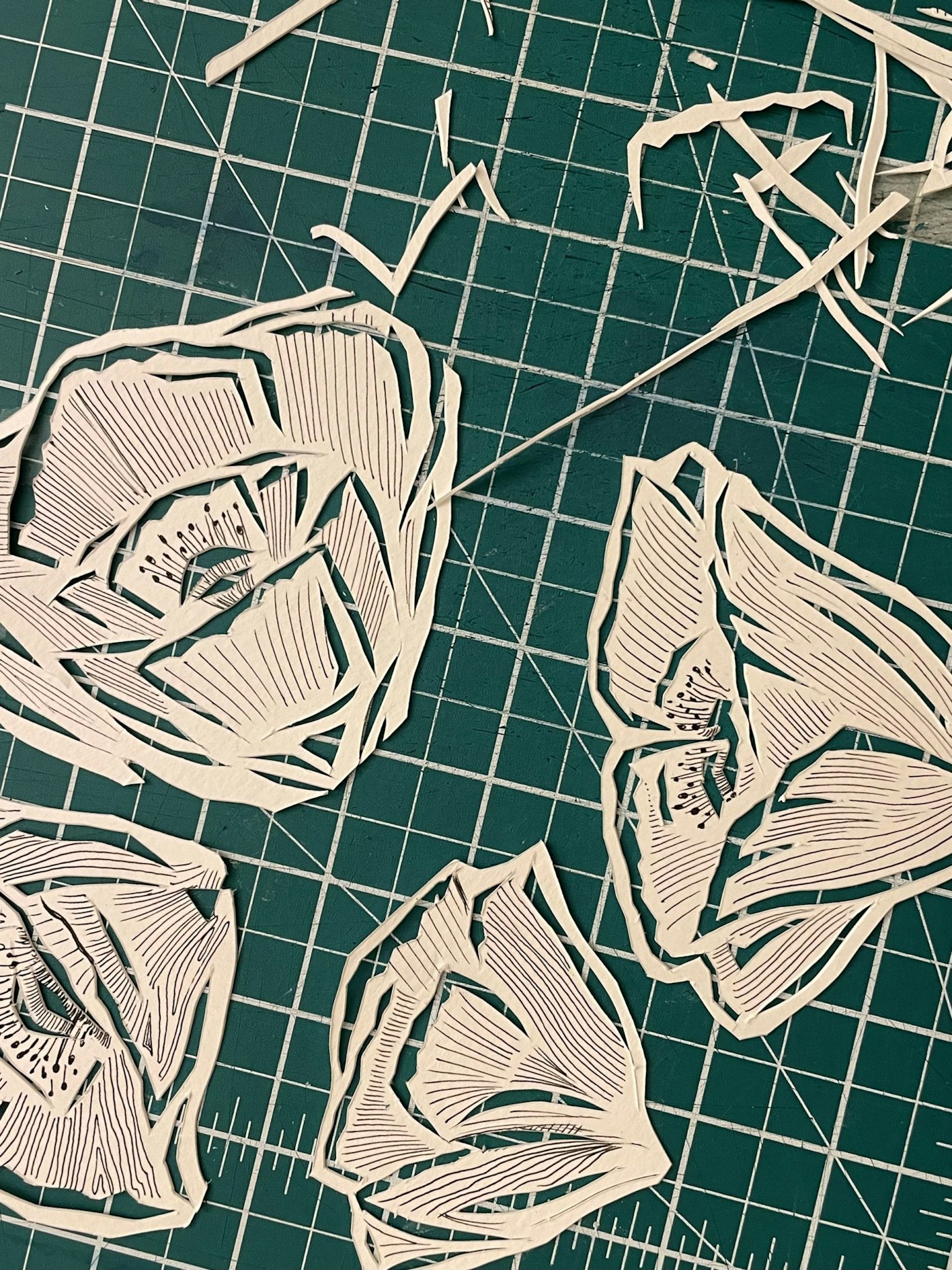
Art in progress – Intricate paper cutouts
Can you discuss any specific themes or symbols present in your artwork that relate to Palestinian culture, history, or resistance?
Mouna: The theme of “return” recurs throughout my work. My father was three when he and his family were forced to flee during the Nakba. Now he’s in his seventies and has never been able to return to the land where his ancestors lived for countless generations. There are too many tragic stories of mass displacement that have taken place throughout history, but the Palestinian refugee experience is quite unique in this regard.
It’s not just that Israel imposes the rule of no right of return. It’s that Israel was founded upon the lie that these places, these homes and these lives never even existed. That they’re not worthy of being remembered, returned to, or reclaimed because they are nothing more than a “bedouin” fiction. The very thought of this, the indignity and the cruelty of it, absolutely haunts me.
Without the ability to return, millions of Palestinian families like my own, live and will continue to live as refugees in perpetuity. My work seeks to ask the question: why, of all people, have we been left to this fate? Will we ever return? And what does it mean to feel anchored to a land where you hold no real memories, other than those that have been passed on to you through your unique genetic code?
In what ways do you believe art serves as a form of resistance and a means of preserving memories for Palestinians?
Mouna: Making and sharing art has always been a vital and accessible form of resistance. Art doesn’t need to be large, lofty or grand in order to make a meaningful difference. I have this quote in the front of my sketchbook that reads: “An ounce of action is worth a tonne of theory”, and that’s what I always have in mind when I’m making something. The act of making is resistance. The act of sharing is resistance. And the act of continuing to create, despite feeling that everything is unbelievably bleak, is an act of resistance too.
One of the things I’m most proud of are the solidarity stickers packs that I’ve created because they require direct action. I designed a “Ceasefire Now” set initially, then a “We are all Palestinians” set, and then a set specifically designed for children. Each of these stickers, stuck up by someone somewhere across the country, also represents an act of resistance.
What do you hope to achieve with your work?
Mouna: I am extremely proud to be Palestinian, and my art is a way of articulating this pride and connecting to others who equally are committed to this cause. That said, it’s not enough for me to make something that just looks beautiful. When people look at my work, I want them to ask themselves where they stand and crucially, what they stand for.
Beauty may be the entry point, but conveying the message of Palestinian liberation is always the ultimate goal.
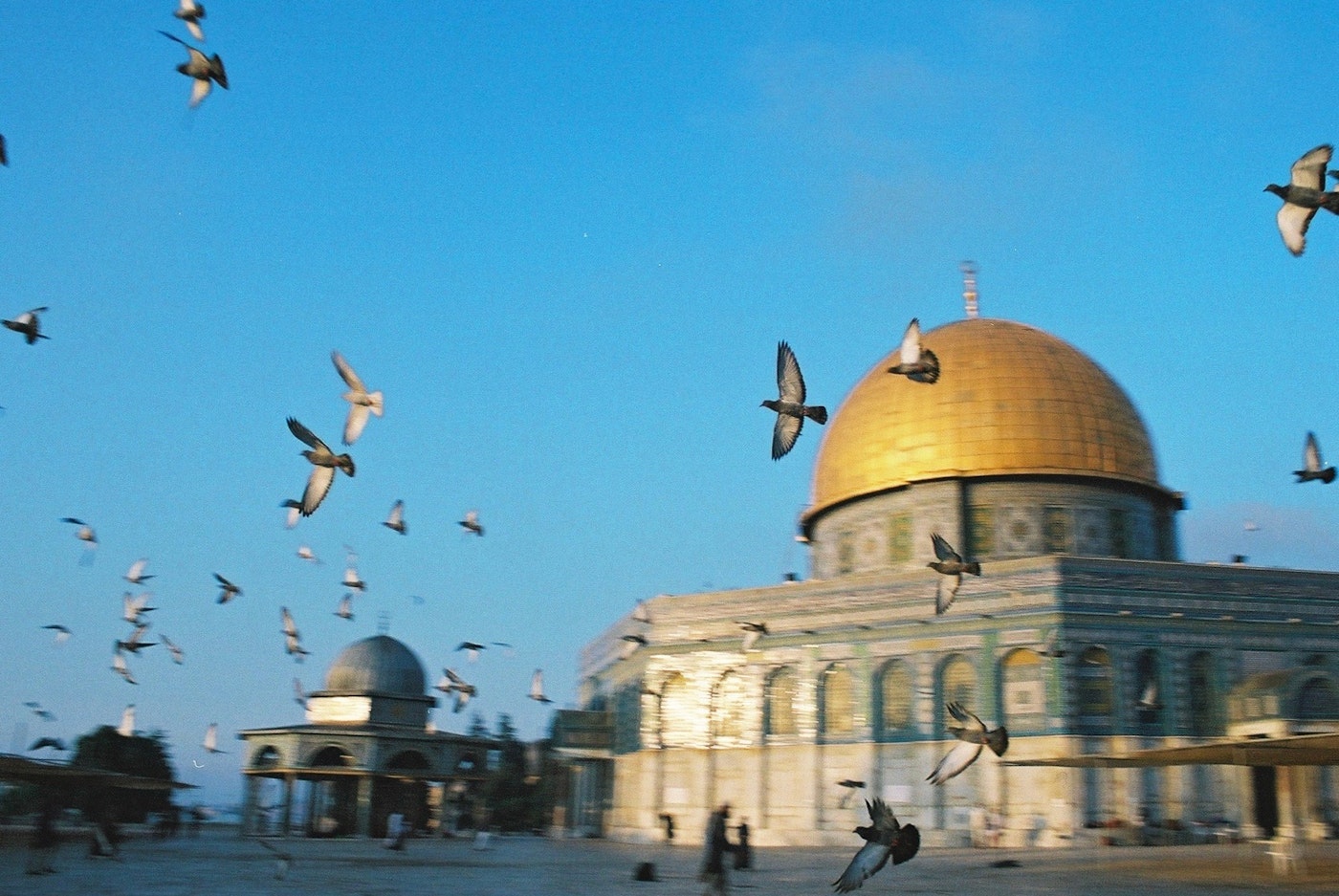
Al-Quds, 2016
When we spoke, you shared with us that you sometimes feel a sense of cultural imposter syndrome. What makes you feel that way?
Mouna: Like most people who are “half” of anything, this feeling is largely context-dependent. Because I didn’t grow up speaking Arabic, I always felt anxious in Arabic-speaking environments and used to dread telling people where I was from. Not because I wasn’t proud, but because I felt that my Palestinian identity was somewhat undermined or even diluted by my inability to comfortably converse in Arabic.
My husband loves languages and decided that he wanted to learn Arabic a few years ago, so we decided to embark on a learning journey together. It has been a very slow process, but it’s helped me shed some of my anxiety.
How do you see your art contributing to the preservation of Palestinian culture and identity, especially in the context of the diaspora community such as in the UK?
Mouna: I am conscious that as a Palestinian living in the West, my understanding, interpretation and lived experience of Palestinian identity (and culture), differs from Palestinians living in Palestine or elsewhere. I don’t intend to speak for or over anyone, so “preservation” is never really top of mind. I just want people to look at my work and remember that Palestine exists. I want them to remember that even when the news cycle changes, Palestinians will be continuing to fight for their basic freedoms. And that it’s on us to commit and keep committing to the cause.
How do you navigate the balance between personal expression and the broader socio-political context in your art?
Mouna: I see these two things as inextricably linked — not just because my artwork was born out of a specific political context (post October 7th), but because Palestinian existence, irrespective of time or context, is inherently and often relentlessly, politicised. I’ve found this to be especially true in my professional life. Working as a Palestinian alongside UK and US-based teams has taught me that my personal identity will always be viewed as a political identity and that most people in the West cannot comfortably uncouple the two.
From my perspective, there’s no point fighting this. If I make work about Palestine, it will always sit against a specific political backdrop. How people choose to interpret it is outside of my hands.
Has your art sparked conversations or connections with others about Palestine and its culture?
Mouna: Through this incredibly small initiative I’ve been able to reconnect with old friends, create new ones and have been asked to design things for musicians, campaigners and small businesses, who want to express their solidarity with the people of Gaza. I’ve received the most incredible feedback from so many people who have bought prints and stickers, telling me how happy they are to have something in their home that reminds them of Palestine.
Most of all, creating and sharing my art has kept me sane. It’s been a great outlet to channel my anger and pain, whilst also connecting me to an ever growing community of people who will not rest until Palestine is free.
Mouna shares her art for Palestine with the world on Etsy, donating all proceeds from the sale of her posters to various charities supporting Palestine. With each creation, she seeks to raise awareness and spark dialogue, contributing to a vision of solidarity and resistance. Through her work, she inspires hope for a future where Palestine, and its people, are free to thrive.
The Power of Artistic Resilience
As both artists reflected on their journey, they are extremely aware of how their very existence has been politicised by the world, a reality which is deeply unjust. Yet, in the face of this hardship, they find comfort and strength in their memories, their culture, their art, and their collective work. They continue to move through a world that often seeks to silence their voices, remaining steadfast in their commitment to their cause, their art, and their people. In their resilience is a clear message of solidarity and a firm determination to see Palestine free.
As Israeli occupation forces deliberately target Palestinian artists, writers and poets in Gaza and West Bank, for Muna and Mouna, every stroke of brush and each motif stitched becomes a symbol of Palestinian resistance and a testament to more than 75 year old struggle for dignity and liberation.
Amaliah Team
This article was written by a member of the Amaliah team or a collective team effort. You can follow us on @amaliah_tweets for the latest or head over to our Instagram @amaliah_com. If you're reading this and are thinking about contributing an article then send us an email with a brief or a full article to contribute@amaliah.com